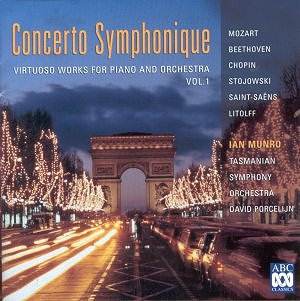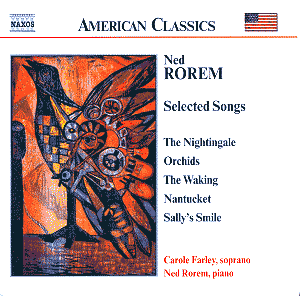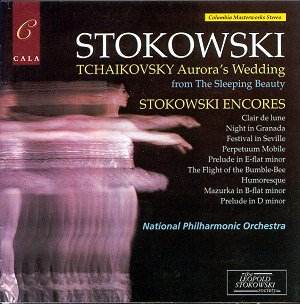 Composer: Wolfgang Amadeus MOZART
Composer: Wolfgang Amadeus MOZART
Works: Rondo in A, K386; Ludwig van BEETHOVEN, Rondo in B flat WoO 6; Frédéric CHOPIN, Variations on La ci darem la mano; Zygmunt STOJOWSKI, Rapsodie Symphonique Op. 23; Camille SAINT-SAËNS, Rapsodie d’Auvergne; Henry LITOLFF, Scherzo (II) from Concerto Symphonique No. 4 in D minor Op. 102
Performers: Ian Munro, piano; Tasmanian Symphony Orchestra; David Porcelijn, conductor
Recording: 16-20 March 1998, Ballroom, Government House, Hobart, Tasmania, Australia
Label: ABC Classics
The recording “Concerto Symphonique – Virtuoso Works for Violin and Piano – Volume 1” presents a fascinating anthology that explores a diverse range of works from classical giants to lesser-known composers, all unified by the virtuosic interplay between piano and orchestra. Anchored by Ian Munro’s dexterous piano performance, this collection deftly navigates through the stylistic nuances of each composer, offering both historical insight and fresh interpretations worthy of close scrutiny.
The disc opens with Mozart’s Rondo in A, K386, where Munro’s articulation shines with clarity and a buoyant charm. The orchestra, under David Porcelijn, complements the piano with a bright sonority that enhances the playful character of the work. Munro’s phrasing captures the elegance of Mozart’s melodic lines, especially in the playful exchanges that characterize the rondo form. This spirited interpretation sets a high bar, echoing the precision of historically informed performance practices while maintaining a contemporary vibrancy.
Transitioning to Beethoven’s Rondo in B flat, WoO 6, one notes a delightful transformation in mood. Munro’s performance is imbued with a sense of humor, particularly in the subtle dynamics and rhythmic variations he employs. The interaction between soloist and orchestra here is particularly noteworthy; the orchestral colorations shift seamlessly, enveloping the piano in a lush soundscape. The rhythmic vitality of Munro’s playing, marked by a wink of irony, showcases his ability to marry technical prowess with interpretive insight—qualities that resonate throughout the album.
Chopin’s Variations on “La ci darem la mano” brings a contrasting lyrical depth to the program. Munro’s interpretation glitters with a sparkling clarity, breathing life into the variations’ intricate textures. The interplay between the piano and orchestra is beautifully balanced, with Munro’s phrasing allowing the melodies to unfold with a gem-like quality. The emotional arc of the piece is captured adeptly, with each variation enhancing the thematic material in a manner reminiscent of Chopin’s own penchant for expressive nuance.
The inclusion of Stojowski’s Rapsodie Symphonique Op. 23 introduces a romantic flair that is both refreshing and engaging. Munro’s performance navigates the lush orchestration with a light touch, revealing the work’s intricate details. The orchestral writing displays an influence of Chausson, particularly in its evocation of symphonic grandeur, which Munro handles with aplomb. The climactic moment at 4:23, where the textures coalesce into a triumphant symphonic statement, is executed with commendable assurance.
Saint-Saëns’ Rapsodie d’Auvergne, while more familiar in the discography, receives a fiery interpretation from Munro. The technical demands are met with a Lisztian flair, particularly in passages marked by virtuosic runs and dramatic flourishes, notably around 4:44 and 5:17. The piano’s final glissando concludes the work in an exuberant display of dexterity, encapsulating the spirited character that defines much of this performance.
the Scherzo from Litolff’s Concerto Symphonique No. 4 serves as a rousing conclusion to this eclectic program. Munro’s joyous facility in navigating the work’s technical challenges is evident, and the orchestral accompaniment supports his energetic interpretation effectively. This piece, a staple of the Romantic piano repertoire, benefits from Munro’s invigorating approach, reminding us of the work’s rightful place in concert halls.
This recording exemplifies not just a collection of piano concertos but rather a thoughtful exploration of the repertoire that straddles the line between the well-known and the obscure. The engineering quality is commendable, capturing the balance between piano and orchestra with clarity and warmth. Munro’s artistry demands attention, and one can only hope that further volumes will follow, continuing to expand upon this innovative concept. The album stands as a testament to the vitality of the concert repertoire, inviting listeners to appreciate the richness of a genre that continues to evolve.



